Fire in the Steppe:
Soviet Tanks, Part Two
by Mike Bennighof, Ph.D.
September 2021
 The Soviet Union’s First Five Year
Plan provided huge numbers of armored vehicles
for the Red Army of Workers and Peasants.
But by the late 1930s, the
tanks of the 1931 program had become largely
obsolete. Soviet engineers labored to produce
new, modern designs to retain their edge. The Soviet Union’s First Five Year
Plan provided huge numbers of armored vehicles
for the Red Army of Workers and Peasants.
But by the late 1930s, the
tanks of the 1931 program had become largely
obsolete. Soviet engineers labored to produce
new, modern designs to retain their edge.
In Panzer Grenadier: Fire in the Steppe the Soviet
arsenal includes both the older tanks and
those of the pre-war program. Here we have
a look at the more modern vehicles designed
just before the outbreak of the Great Patriotic
War.
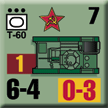
Soviet doctrine included a tank battalion
in every rifle division, almost always comprised
of T-26 infantry support tanks (a few divisions
had the T-37 amphibious tank). Light tanks
also formed the bulk of the Red Army tank
divisions’ armor strength in 1941, but
plans called for replacing most of these with
modern T-34 medium tanks. Light tanks would
be relegated to reconnaissance roles.
Light tanks had other advantages in a socialist
economy: they could be built on automobile
assembly lines that couldn’t accomodate
a larger tank and used the same engines that
powered trucks. Constructing them did not
come at the cost of bigger, more capable machines.
In 1940, the Red Army accepted the T-40 amphibious light tank.
The 5.5-ton tank had a four-bladed propellor
to move it through water, but amphibious performance
was poor and most T-40s had their shaft removed
and the opening plated over. The tank carried
a 12.7mm heavy machine gun and one standard
7.62mm machine gun.
The T-40 disappointed the tank troops, who
disliked its weak armament and poor protection.
Only 220 of them were built. The infantry,
meanwhile, wanted a support tank with greater
firepower like the T-26. In 1940, the T-34
did not seem capable of fulfilling this need,
and so the Defense Committee of the People’s
Commissariat ordered the T-50 light tank.
The T-50 was a handsome little tank, weighing
14 tons and looking like a miniature T-34.
It went into production in April 1941, but
ended up costing slightly more than the medium
tank, and so production was halted after only
65 had been built. The T-50 had very modern
features: sloped armor, welded construction,
a good reliable engine yielding excellent
speed, and unlike other types a radio in every
tank.
By mid-summer 1941 the T-34 had shown
its worth in combat, but the Defense Committee
wanted to build huge numbers of light tanks
in factories that could not handle the bigger
vehicle. The T-60 was quickly designed to
this requirement, re-working the T-40 chassis
to carry more armor, but it was still vulnerable
to the German 37mm anti-tank gun. A small
turret offset to one side held a 20mm automatic
cannon adapted from an aircraft weapon.
The T-60 had been intended to operate easily
in snow and mud conditions, but failed this
requirement. It made its combat debut in large
numbers during the Soviet winter offensive
of December 1941 and January 1942. Production
continued until late 1942, and 6,292 of the
machines were built.
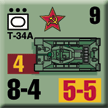
The most famous tank of the Second World
War, the T-34, began in a late 1937 project
when Kharkiv Locomotive Works were ordered
to create another in the BT series of wheel/track
fast tanks. The tank was to weigh no more
than 15 tons, and be armed with a 45mm gun.
At the same time, the works received orders
to design a larger tank with a 76.2mm gun,
also to run on either wheels or tracks.
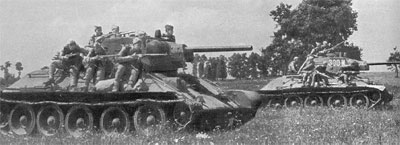
T-34/76 tanks with tank riders.
The design team jettisoned the wheeled capability
in order to improve off-road performance,
and when they presented their plans the People’s
Commissar for Defense, Klimenti Voroshilov,
lambasted them for disobeying a direct order.
The chief engineer, Mikhail Koshkin, stood
up to the Marshal and insisted that his team
could meet the specified speeds on tracks
alone. Josef Stalin intervened personally,
directing that the engineers be given a chance
to build prototypes of the two tanks and show
their worth.
The prototype that would become the T-34
made the drive from Kharkiv to Moscow in the
spring of 1940, and was demonstrated for the
Soviet leadership inside the Kremlin. After
more testing, the order went out to begin
series production, and the first models rolled
off the lines in July 1940.
The new tank had sloped armor, excellent
off-road mobility, and after February 1941
a new 76.2mm tank gun. On the negative side,
only platoon commanders’ vehicles had
radios, and German anti-tank gunners eventually
learned to concentrate their fire on these.
Over 35,000 T-34/76 tanks would be built
by the time they were replaced by the T-34/85
in 1944, an astounding total. Several of the
factories building them were re-located east
of the Ural mountains during the course of
the war. One of them, the Stalin combine,
began production before the factory buildings
were complete and workers assembled tanks
in the frigid outdoor weather. In the Stalingrad
Tractor Works, tanks came off the assembly
line in one end of the huge building and joined
Red Army troops battled the Hitlerites infesting
the other end.
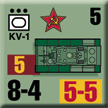 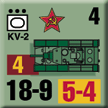
Soviet pre-war doctrine also assigned heavy
tanks the role of attacking prepared positions,
and in February 1939, S.J. Kotlin went against
Soviet multi-turret practice with a single-turreted
heavy tank. Knowing who he had to please,
he named his new tank the Klimenti Voroshilov.
Known as the KV, the tank had heavy armor
and a 76.2mm gun. Two of them were tested
in the Winter War against Finland in late
1939, with series production under way by
the middle of the next year. A variant model,
the KV-2, had a huge turret with a 152mm howitzer that could only be fired once every three minutes.
The KV series featured thick armor, which
German troops came to believe was totally
invulnerable. This was not quite true, but
the KV was very tough. Its engine was prone
to break down, however, as the tank’s
weight strained the power plant. The 76.2mm
gun also gave it no greater firepower than
the T-34 medium tank, with somewhat better
protection but much less manueverability.
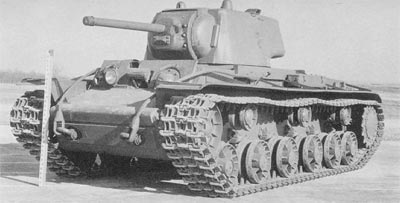
The KV-1. Disliked by Red Army troops;
disliked by German ones even more.
“The KV, Comrade Stalin, is not popular
with the troops,” reported Hero of the
Soviet Union M.J. Katukov, one of the Red
Army’s top tankers. “What advantages
does the heavy tank offer us in battle? Yes,
if it had a bigger gun, then we could get
along with its higher weight and other design
faults.”
Production continued anyway, and the KV
was not phased out until 1943.
Despite its many flaws, the KV was better
than anything in the German inventory.
You can order Fire in the Steppe right here.
Sign up for our newsletter right here. Your info will never be sold or transferred; we'll just use it to update you on new games and new offers.
Mike Bennighof is president of Avalanche Press and holds a doctorate in history from Emory University. A Fulbright Scholar and NASA Journalist in Space finalist, he has published far too many books, games and articles on historical subjects.
He lives in Birmingham, Alabama with his wife, three children and his dog, Leopold.
|
